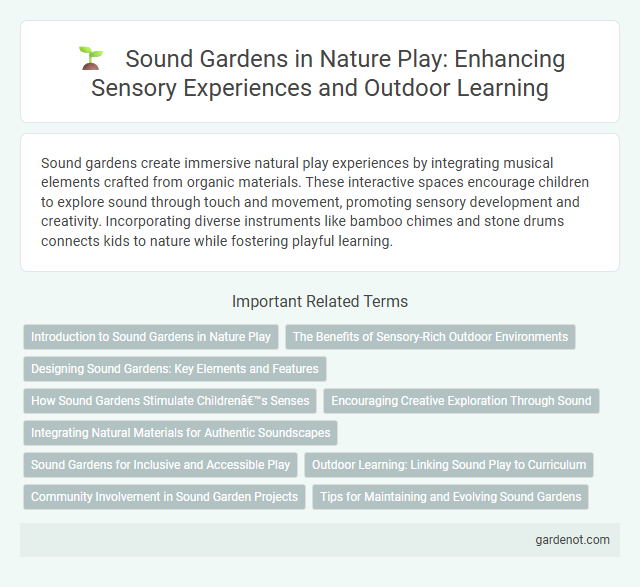Sound gardens create immersive natural play experiences by integrating musical elements crafted from organic materials. These interactive spaces encourage children to explore sound through touch and movement, promoting sensory development and creativity. Incorporating diverse instruments like bamboo chimes and stone drums connects kids to nature while fostering playful learning.
Introduction to Sound Gardens in Nature Play
Sound gardens in nature play create immersive environments where children explore natural and crafted sounds through interactive installations like chimes, drums, and resonant plant materials. These sensory-rich spaces enhance auditory development and encourage creative expression by integrating the sounds of wind, water, and wildlife with human-made instruments. By fostering active listening and sound experimentation, sound gardens deepen children's connection to the natural world while supporting cognitive and emotional growth.
The Benefits of Sensory-Rich Outdoor Environments
Sound gardens enhance sensory learning by immersing children in natural auditory experiences, promoting cognitive development and emotional well-being. Exposure to diverse sounds in outdoor environments improves auditory processing, creativity, and mindfulness. These sensory-rich spaces foster a stronger connection to nature, encouraging exploration and stress reduction.
Designing Sound Gardens: Key Elements and Features
Designing sound gardens involves integrating natural materials like wood, stone, and water to create interactive auditory experiences that encourage exploration and sensory engagement. Key elements include varied sound-producing features such as chimes, drums, and resonant surfaces strategically placed to invite movement and creativity. Incorporating natural acoustics and diverse sound textures enhances the immersive quality, promoting relaxation and learning through nature play.
How Sound Gardens Stimulate Children’s Senses
Sound gardens stimulate children's senses by creating immersive auditory experiences using natural and crafted instruments like chimes, drums, and xylophones made from wood, metal, and stone. These interactive elements encourage exploration, enhance auditory discrimination, and promote creativity by allowing children to experiment with different sounds and rhythms. Exposure to varied natural sounds in sound gardens also supports cognitive development and emotional regulation through sensory engagement in outdoor play environments.
Encouraging Creative Exploration Through Sound
The Sound Garden offers an immersive environment where children engage with natural and crafted instruments to explore sound waves, rhythms, and harmonies. Interactive elements like wind chimes, drums, and xylophones stimulate auditory senses, promoting cognitive development and imaginative play. This sensory-rich space encourages creative expression and enhances emotional well-being through hands-on sonic experimentation.
Integrating Natural Materials for Authentic Soundscapes
Sound gardens incorporate natural materials like bamboo, wood, and stone to create authentic soundscapes that engage children's auditory senses. These materials produce diverse organic tones and rhythms, enhancing sensory exploration and environmental awareness. Integrating elements such as hollow logs or water features fosters interactive, nature-based play that stimulates creativity and calmness.
Sound Gardens for Inclusive and Accessible Play
Sound gardens create immersive sensory experiences that enhance inclusive and accessible play environments by integrating interactive musical elements tailored for children of all abilities. These gardens feature adaptive instruments such as large chimes, drums, and touch-responsive surfaces designed to engage diverse sensory preferences and motor skills. Implementing sound gardens promotes social interaction, cognitive development, and emotional well-being while fostering equity in outdoor play spaces.
Outdoor Learning: Linking Sound Play to Curriculum
Sound gardens provide a dynamic outdoor learning environment where children explore acoustic properties through interactive natural elements like bamboo chimes, wooden drums, and water sounds. Integrating sound play into curriculum supports sensory development, auditory discrimination, and creative expression, aligning with music, science, and environmental studies standards. This hands-on approach fosters experiential learning, encouraging inquiry and engagement with natural soundscapes in early childhood education.
Community Involvement in Sound Garden Projects
Community involvement in Sound Garden projects fosters environmental awareness and social cohesion by engaging local residents in the design, construction, and maintenance phases. Collaborations with schools, artists, and environmental organizations amplify educational outreach and create inclusive spaces that reflect diverse cultural soundscapes. Active participation cultivates a sense of ownership and stewardship, enhancing the sustainability and resonance of Sound Gardens within neighborhoods.
Tips for Maintaining and Evolving Sound Gardens
Regularly inspect Sound Gardens for wear and tear, ensuring all instruments remain functional and safe for children to explore. Introduce seasonal plantings or natural elements like bamboo or hollow logs to enrich acoustic textures and encourage diverse sound experiences. Engage the community in co-creating new sound features, fostering ongoing interaction and evolving the sensory landscape of the Sound Garden.
Sound garden Infographic

 gardenot.com
gardenot.com